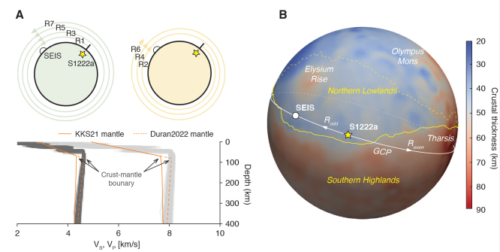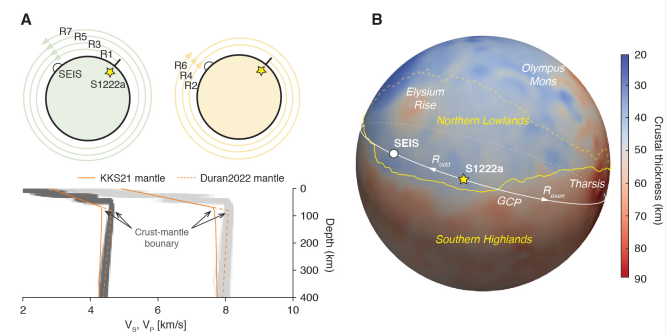2023-05-16 スイス連邦工科大学チューリッヒ校(ETHZurich)
◆火星の地殻は地球や月の地殻よりも平均的に厚く、主な熱源は放射能です。また、火星の南北半球の地殻の密度は類似しており、厚さには大きな違いがあります。
◆この研究は、火星の地球や月との比較から、火星の地殻の特性や熱生成のメカニズムに関する重要な洞察を提供しています。
<関連情報>
- https://ethz.ch/en/news-and-events/eth-news/news/2023/05/martian-crust-like-heavy-armour.html
- https://essopenarchive.org/users/549578/articles/627343-global-crustal-thickness-revealed-by-surface-waves-orbiting-mars
火星を周回する表面波が明らかにした全地殻の厚さ Global crustal thickness revealed by surface waves orbiting Mars
Doyeon Kim, Cecilia Duran, Domenico Giardini, Ana-Catalina Plesa, Simon C. Stähler, Christian Boehm, Vedran Lekic, Scott M. McLennan, Savas Ceylan, John Clinton, Paul McEwan Davis, Amir Khan, Brigitte Knapmeyer-Endrun, Mark Paul Panning, Mark A. Wieczorek, Philippe Lognonné
Geophysical Research Letters Published:06 Mar 2023
DOI:https://doi.org/10.22541/essoar.167810298.85030230/v1

Abstract
We report observations of Rayleigh waves that orbit around Mars up to three times following the S1222a marsquake. Averaging these signals, we find the largest amplitude signals at 30 s and 85 s central period, propagating with distinctly different group velocities of 2.9 km/s and 3.8 km/s, respectively. The group velocities constraining the average crustal thickness beneath the great circle path rule out the majority of previous crustal models of Mars that have a >200 kg/m3 density contrast across the dichotomy. We find that the thickness of the martian crust is 42-56 km on average, and thus thicker than the crusts of the Earth and Moon. Together with thermal evolution models, a thick martian crust suggests that the crust must contain 50-70% of the total heat production to explain present-day local melt zones in the interior of Mars.




